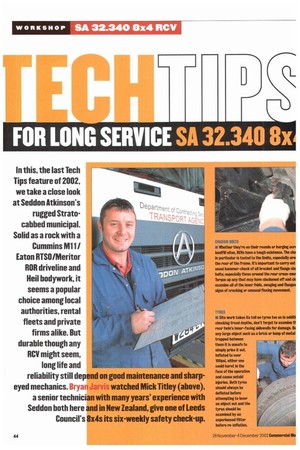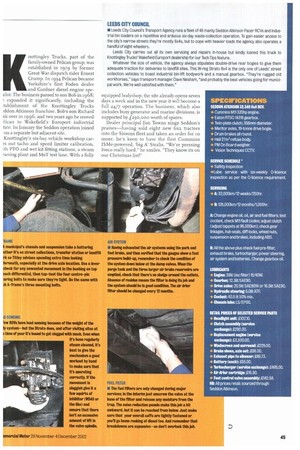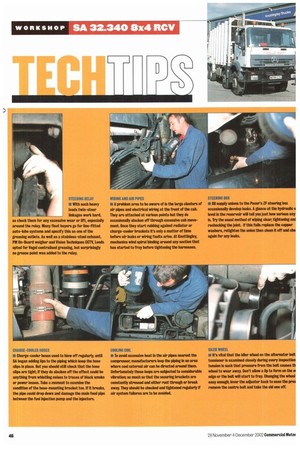CHASSIS Ras
Page 44

Page 45

Page 46

If you've noticed an error in this article please click here to report it so we can fix it.
* Whether they're on their rounds or barging acri landfill sites. RCVs have a tough existence. The cha In particular is tested to the limits. especially are the rear of the frame. rt's important to carry out usual hammer-check of all bracket and flange cia bons; especially those around the rear cross-mer Torque up any that may have slackened off and cic examine all of the inner folds, swaging and flanges signs of cracking or unusual flexing movement. A municipal's chassis and suspension take a battering ether it's on street collections, transfer station or landfill rk so Tilley advises spending extra time looking ierneath, especially at the drive axle location. Use a lever check for any unwanted movement in the bushing on top each differential, then tap-test the four centre-pin Hiring bolts to make sure they're tight. Do the same with ;11A-frame's three mounting bolts.
AIR SYSTEM
• Having exhausted the air systems using the park and foot brake, and then verified that the gauges show a fast pressure build-up, remember to check the condition of the system down below at the dump valves. When the purge tank and the three larger air brake reservoirs are emptied, check that there's no sludge around the outlets. Absence of residue means the filter is doing its job and the system should be In good condition. The air drier filter should be changed every 12 months.
Site work takes its toll on tyres too so in additi checking tread depths, don't forget to examine tf rear twin's Inner-facing sidewalis for damage. Bu any large object such as a brick or lump of metal trapped between thorn it Is unsafe to simply prise it out. Inflated to over 100psi, either one could burst in the face of the operative and cause untold injuries. Both tyres should always be deflated before attempting to lever an object out and the tyres should be examined by an experienced fitter before re-inflation.
kiw RCVs have load sensing because of the weight of the ly system—but the Strata does, and after visiting sites at s time of year it's bound to get clogged with muck. Even when it's been regularly steam cleaned, it's best to give the mechanism a good workout by hand to make sure that it's operating correctly. If the movement Is sluggish give It a few squirts of Inhibitor IWD40 or the like) and ensure that there isn't an excessive amount of lift in the valve spindle.
FUEL FILTER
• The fuel filters are only changed during major services; in the interim just unscrew the valve at the base of the filter and release any moisture from the trap. The noise reduction panels make this job a bit awkward, but it can be reached from below. Just make sure that your overall cuffs are tightly fastened or you'll go home reeking of diesel too. And remember that breakdowns are expensive—so don't overlook this job. IN With such heavy loads twin-steer linkages work hard, so check them for any excessive wear or lift, especially around the relay. Many fleet buyers go for line-fitted autolube systems and specify this as one of the greasing outlets. As well as a stainless-steel exhaust. PM On-Board weigher and Vision Techniques CCTV, Leeds opted for Vogel centralised greasing, but surprisingly no grease point was added to the relay.
WIRING AND AIR PIPES
• A problem area to be aware of is the large clusters of air pipes and electrical wiring at the front of the cab. They are attached at various points but they do occasionally slacken off through excessive cab movement. Once they start rubbing against radiator or charge-cooler brackets it's only a matter of time before air leaks or wiring faults arise. At Knottingley, mechanics wind spiral binding around any section that has started to fray before tightening the harnesses.
Oil supply unions to the Pacer's ZF steering box occasionally develop leaks, A glance at the hydraulic level in the reservoir will tell you Just how serious any is. Try the usual method of wiping clear. tightening am rechecking the joint if this fails replace the copper washers, retighten the union then clean it off and the again for any leaks.
CflARGE-GOOLER HOSES Charge-cooler hoses used to blow off regularly, until SA began adding lips to the piping which keep the hose clips in place. But you should still check that the hose clips are tight; if they do slacken off the effect could be anything from whistling noises to traces of black smoke or power losses. Take a moment to examine the condition of the hose-mounting bracket too. If it breaks, the pipe could drop down and damage the main feed pipe between the fuel Injection pump and the injectors. COOLING COIL • To avoid excessive heat In the air pipes nearest the compressor, manufacturers loop the piping in an area where cool external air can be directed around them. Unfortunately these loops are subjected to considerable vibration; so much so that the securing brackets are constantly stressed and either rust through or break away. They should be checked and tightened regularly if air system failures are to be avoided. IDLER WHEEL • It's vital that the idler wheel on the alternator belt tensloner is examined closely during every inspection tension Is such that pressure from the belt causes th wheel to wear away. Don't allow a lip to form on the or edge or the belt will start to fray. Changing the wheel easy enough; lever the adjuster back to ease the pros remove the centre bolt and take the old one oft.




































































































































































